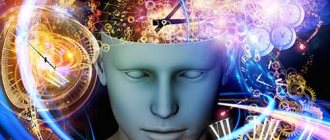Human consciousness is a subjective experience of external reality, which is expressed in self-report of these events. A broader definition of the concept of consciousness is a property of the psyche through which external events are reflected, regardless of the level of implementation (biological, social, sensory or rational). In a narrower sense, this is a function of the brain, characteristic only of people, which, associated with speech, is expressed in the purposeful and generalized reflection of the phenomena of reality, the preliminary construction of actions in the mind and the prediction of results, and manifests itself in the rational management and self-control of actions through reflection.
The concept of human consciousness is the subject of research in many sciences (psychology, philosophy, sociology); scientists are trying to uncover the meaning of the existence and occurrence of such a phenomenon.
Consciousness is a synonym: reason, comprehension, understanding, comprehension, thought, reason, they will be used later in the text.
Forms of consciousness
There is individual and social consciousness. The first, individual, is the consciousness of each individual about his individuality of being, through his social being. It is an element of social consciousness. Consequently, secondly, the concept of social consciousness is the generalized individual consciousness of various individuals. This generalization occurs historically, over a long period of time. Therefore, it is also considered group.
In group consciousness, it is necessary to consider two features - this is the social contact of people as an important factor and the common strength of these people when combining their individual forces.
Each collective constitutes a group of different individuals, however, not every group of individuals will be a collective. Based on this, the manifestation of collective consciousness will always be group, and group consciousness will not always be collective. Collective intelligence is, firstly, a manifestation of social consciousness as a social idea, and secondly, this idea determines the activities of individuals in this collective.
Individual awareness of typical individuals always determines group awareness. But only what is typical for a certain group, which is suitable in terms of frequency of manifestation, strength of expression at any time, that is, what is ahead, directs the development of this group.
Collective and group forms of consciousness are dependent on social consciousness and are determined by the relationships between group members. Thus, those mental phenomena that are characteristic of the communication process represent different phenomena in group consciousness.
The latter, in turn, is divided into several forms of consciousness. The most specific are mass phenomena; they constitute public moods and create a group psychological climate. These moods are mostly caused by interpersonal relationships. If the group has good, warm and trusting relationships, then the psychological climate will be favorable and it will be easier for such a group to solve problems. But if a person is introduced into such a team, dissipating hostility between group members, naturally, the psychological climate will deteriorate, and labor efficiency will begin to decline. Also, the mass mood in the group can be affected by didactogenies - these are changes in mood that reach a painful state and are caused by rude behavior and the influence of the leader.
Another form of group consciousness is panic. Panic is a manifestation of fear, a state of passion that captures an entire group and, under the influence of mutual imitation, intensifies even more.
Fashion is a form of group consciousness when people begin to imitate each other, follow public opinion and rely on information from the media regarding what they should wear, dress, put on shoes, and what music to listen to.
Collective thinking is also a form of group consciousness; it reinforces the focus of each member in solving the team’s task, makes it possible to think through it and illuminate it from different angles, and also promotes initiative. Collective thinking adds criticality to decisions, and this contributes to the development of self-criticism in each member of the group, enriches the knowledge and experience of some by acquiring knowledge from others, creates a positive emotional tone, creates situations of competition, increasing efficiency, and reduces the time for solving the task. Solving one task contributes to the emergence of new ones and thus stimulates the development and progression of the group; collective thinking moves the team forward.
The form of social consciousness is divided into several types: religion, science, law, morality, ideology and art. Forms such as religion, law, morality and art, as social phenomena, are relatively independent and are studied by different sciences. Moral and aesthetic consciousness have a connection that can be observed every day, for example, moral actions are often characterized as beautiful, and vice versa, immoral actions are called disgusting or ugly.
Religious art through church painting and music is used to deepen religious feelings and, in general, the religious consciousness of each individual and entire groups. In small groups, religious awareness is a phenomenon from religious psychology, which includes the religious worldview of the individual and groups.
The philosophical type of consciousness is a theoretical worldview, knowledge about the laws of nature, man and society; it highlights methods of their knowledge. Displays existence in a conceptual form, performs epistemological and ideological functions.
The scientific nature of consciousness is a rational, systematized reflection of the world around us through the application of scientific theories, arguments and facts, and is reflected in the minds of people in the categories of laws and theories. It allows a person to think in categories, to apply various principles of cognition in order to make new discoveries. The application of scientific consciousness can be seen in all possible spheres of human existence.
Morality, as a form of awareness, has emerged and changed, as well as the moral psychology of a group, which generalizes the socially beneficial experience of communication in groups and in appropriate conditions.
Morality of consciousness is based on the category of morality, it is the most ancient form of social consciousness, and it also passes through all areas of human activity (profession, everyday life, family). It is reflected in the categories by which a person thinks and is guided: good, evil, conscience, dignity and others. Morality is determined by the outlook of specific societies and classes. Moral norms reflect universal, that is, independent of social class, moral values: humanism, honor, responsibility, compassion, collectivism, gratitude, generosity.
The political nature of consciousness began to emerge with the formation of the state, classes and the sphere of politics. It reflects the interactions of classes and social groups, the place and their role in state power, the relations between nations and states, oriented by economic motives. It integrates all forms of social consciousness. It is influenced by various spheres: religion, science, law, but the political remains the leading one. It is also an element of the functioning of the country's political system. It has two levels: the everyday practical level and the ideological-theoretical level. At the everyday theoretical level, experience and tradition, the emotional and the rational, experience and traditions are interconnected; it appears spontaneously, from the activities and life experiences of people. It is also unstable because it exists under the influence and dependence of living conditions, people's emotions and constantly changing experiences.
The use of everyday consciousness is important because it is characterized by the integrity of life understanding, and with creative processing it is the basis of theoretical consciousness. Theoretical political consciousness is characterized by a completeness and depth of reflection of political reality, characterized by the ability to predict and systematize views. It can develop a political program based on the economic and social spheres. Such a political ideology is capable of actively influencing the level of public consciousness. Only specially trained people who work on understanding the laws of social life and engage in “political creativity” work on the creation of ideology. A well-formed ideology can influence the consciousness of society as a whole, since it is not just a system of beliefs, but a well-structured propaganda that permeates all layers and spheres of society, which uses state power and uses the media, science, culture, and religion.
Legal consciousness has a very strong connection with the political, since it contains political as well as economic interests of various social groups. It affects various spheres of social life, in which it performs the following functions: regulatory, cognitive and evaluative.
Also legal, it has a historical nature, and its development occurs depending on economic and political circumstances and living conditions, it arises along with the first manifestations of the political organization of society, law and class division and reflects the relationships of people, organizations, government bodies that are bound by rights and obligations, their guarantor is the law.
Economic awareness reflects knowledge and theories of economic activities and social needs. It is formed under the influence of historical conditions and is determined by the need to understand economic and social changes. It also aims to improve economic reality.
Ecological aspects of human consciousness perform social functions. First of all, cognitive and educational functions. It is interconnected with other forms of consciousness: moral, aesthetic and legal. The state of ecology requires a person to have an aesthetic and moral attitude towards the surrounding nature; otherwise, a person succumbs to the influence of legal consciousness in order to pay for the damage caused to nature.
Environmental awareness consists of a humane attitude towards nature, a person’s awareness of himself as a part of this nature. The criterion for this is the spiritual need for careful attitude and desire to preserve the beauty of nature.
Consciousness and unconsciousness
A state of awareness is a state of a person in which he is able to clearly see and comprehend everything that is happening around him and what is happening directly to him, is able to control his actions and monitor the development of events around him.
The unconscious is uncontrolled, unconscious actions and special mental manifestations. These are two different poles of the psyche, but they are in connection and interaction.
Psychoanalysis was the first in psychology to study individual consciousness and the unconscious, their relationship and how they manifest themselves in behavior. According to this school of thought, a person’s awareness is just no more than one tenth of the psyche. The majority is made up of the unconscious, in which instincts, desires, emotions, fears are stored; they are always with a person, but only sometimes they appear and at that moment control the person.
Consciousness is synonymous with awareness and this term will also be used. So, the conscious is that which is controlled by a person, the unconscious is that which cannot be controlled, only it itself is capable of influencing a person. Insights, dreams, associations, reflexes, instincts - appear without our will, also intuition, inspiration, creativity, impressions, memories, obsessive thoughts, slips of the tongue, slips of the tongue, illnesses, pains, impulses - manifestations of the unconscious, sometimes some of them can appear completely inopportune moment or if the person does not expect it at all.
Thus, there is a connection between the unconscious and the conscious, and today no one dares to refute it. Both the conscious and the unconscious are intertwined in a person and influence both him and each other. The unconscious sphere can open up to a person, which establishes what internal motivations and forces drive a person, his thoughts and actions, outside of consciousness.
Guided by this knowledge, you can greatly improve your life, learn to trust your intuition, become open to creativity, work on your fears, open to insights, listen to your inner voice, and work through repressed desires. All this requires a reserve of strength and desire, but then in order to fully understand yourself, develop, achieve goals, get rid of complexes, you need to engage in introspection and deep self-knowledge.
The unconscious relieves the mind of unnecessary stress and protects against information overload. It contains negative experiences, fears, information traumatic to the psyche and, thanks to this, protects a person from psychological stress and breakdowns. Without such a mechanism, people would not be able to withstand all the pressures from the outside world. Thanks to liberation from negative experiences or outdated unnecessary information, a person is able to fully realize himself.
Protection of a person’s consciousness is manifested in freeing him from constant control over the actions that he carries out every day. Actions such as brushing teeth, using appliances, riding a bicycle, and many others become automatic and do not require thinking about the actions. Also, an adult does not notice how he makes words from letters when he reads, and does not think about what actions he needs to perform in order to walk. In the same way, actions become automatic in professions.
Because some information passes into the unconscious area, much more space is freed up for assimilation of new information, and the mind more easily concentrates on new important tasks. But we must not forget that even what has gone into the unconscious does not disappear without a trace, it is stored, and under the influence of some stimulus it is able to break out, because, in any case, it is part of a person.
The conscious and unconscious psyches are of equal importance to people, and the functionality of either of them cannot be underestimated.
History of the issue.
Questions about the origin and location of consciousness were first formulated by scientists who lived before our era. Hippocrates was the first doctor to connect the human psyche with his brain. And the founder of the Athenian Academy, Plato , believed that a person is able to think about himself only thanks to his immortal soul.
In the 17th century, French mathematician and philosopher René Descartes developed the concept of the dual nature of man: a material body and an immaterial soul. Further study of consciousness in philosophy and science is associated with the great natural scientists: Wilhelm Leibniz, George Berkeley, John Locke .
Psychology as a science of consciousness separated from philosophy in the mid-19th century. At the same time, the first experimental laboratory dedicated to the study of this phenomenon was created in Leipzig. With the advent of Sigmund Freud, the world was faced with the other side of consciousness - the unconscious. Since the mid-20th century, cognitive science has been studying cognitive processes in the brain. Scientific discoveries in the field of studying consciousness were made by Wilhelm Wundt, Roger Sperry, Roger Penrose, Alexander Luria, John Searle, Natalya Bekhtereva, Lev Vygotsky .
There is no single, shared idea of consciousness.
Do you want to make better decisions, find your ideal career, realize your maximum potential and receive instructions for individual development?
?
All this can be done using the Human Design
. Build your map and get basic decryptions for free.
There are many contradictory definitions and meanings embedded in this concept: from the subject’s idea of himself and the world around him to a kind of repository of the thought process at a certain point in time. Some scientists compare consciousness to the ether, which is distributed in the Universe, and the human brain to a receiver. Others argue that not only humans have self-awareness, but also any sentient and reacting being, and even a living cell. Still others generally call consciousness an illusion.
There is no single opinion about the emergence of consciousness. Some associate its origin with the natural or “bodily” principle. Others attribute to it divine origin and argue that human consciousness, like the soul, was “implanted” into the body by a higher mind. There are scientists who believe that consciousness does not fit into the physical picture of the world, therefore the scientific approach to its study is not applicable in principle.
Consciousness and self-awareness
The concept of human consciousness is also used in the context of self-awareness. The properties of consciousness are that it, as the personal core of a person, contains feelings, sensations, thoughts and emotions. The meaning of self-awareness is that it is a person’s attitude towards himself. It turns out that both concepts are parts of a single whole.
If we look back at the history of mankind, primitive people had only underdeveloped awareness, which developed in stages. It began with the fact that a person felt his body on a physical level and understood the limitations of his abilities. After exploring his body, he began to explore the outside world, from which his mind gained new information, which stimulated his development. The more a person gets acquainted with different objects, the more he knows how to find their differences and learn new properties.
The formation of self-awareness happened a little later. At first, man was guided only by innate instincts (reproduction, self-preservation). Thanks to self-awareness, man managed to rise above such primitivism, and the emergence of hierarchy in communities contributed to this. Each group had a leader whom everyone listened to, followed his instructions, and accepted criticism and praise. Thus, people became above their instincts, because they began to do something not specifically for themselves alone, but for the whole group and the leader. This is a manifestation of self-awareness in the external world, and not inside the human consciousness. Even later, the individual began to listen to his own voice and act in relation to what he “heard,” this allowed him to rise above instincts, fleeting desires and other factors that interfered with personal development.
In the development of modern man, the formation of consciousness and self-awareness also appears in stages. At first, the child gradually becomes aware of himself, then finds himself under the guidance of adults. Later, external managers are replaced by internal ones. But this development has not reached everyone. In undeveloped countries, there are people who still live according to their old instinct.
Without self-awareness, a person cannot go further in his personal development, achieve goals, get along with people around him, or become successful. With the help of self-awareness, a person sees and makes his life the way he wants. All successful people have this property. Otherwise, they would not be able to become intelligent and develop intelligence.
By the way, categories such as consciousness and intelligence are often compared. Many people believe that if there is consciousness, then this also indicates intelligence, but these categories have different meanings. An intelligent person is not always conscious. The level of consciousness among less educated people may be higher. Therefore, consciousness and intelligence are not identical concepts. But with the help of self-awareness, intellectual capabilities develop. The properties of self-awareness and consciousness constitute the life of a modern person, help him in gaining freedom, otherwise it would remain only within the framework of desires.
Self-esteem
Self-esteem is an individual’s opinion about himself, his assessment of his own qualities, strengths and weaknesses, which is based on comparing himself with other people. Unlike self-awareness, self-esteem always involves evaluation, comparison, juxtaposition, and the presence of an outside view of oneself. A person’s self-esteem is an integral part of self-awareness, but self-awareness can exist in its pure form, without self-esteem.
Psychologists distinguish three main types of personality self-esteem:
- Suspended self-esteem is a person’s biased ideas about himself, assessing only his own merits and actually ignoring his shortcomings. On the one hand, high self-esteem gives an individual self-confidence, helps him achieve his goals and objectives (after all, the more faith a person has in his own abilities, the more strong-willed and purposeful he becomes). On the other hand, an inflated level of self-esteem does not allow a person to develop, because people, confident that they know and can do everything, stop learning from others, thus, they begin to gradually degrade.
- Low self-esteem is an individual’s distorted perception of himself, due to which he cannot see his own merits and focuses only on his shortcomings. In this case, the influence of self-esteem has an even more detrimental effect on personality development than in the case of inflated self-esteem. An individual with low self-esteem experiences discomfort in communicating with others (after all, he constantly compares himself with others and finds that he is much worse than others), feels inferior, unworthy, and does not believe in his own strength. People with low self-esteem cannot fully realize their talents and abilities, and are afraid to set high goals for themselves and achieve them.
- Adequate self-esteem is an individual’s objective perception of himself, an assessment of his own strengths and weaknesses that is close to reality. A person with such self-esteem knows that there are people superior to him in qualities, and there are people who have not yet reached the same level of development as himself. In this case, self-confidence cannot become excessive, since the person sees and recognizes his shortcomings and strives to correct them.









